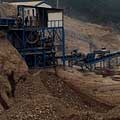Iron Ore Minerals: How Are They Extracted?
November 9, 2017
A planet without iron would be a very hard place to live in, right? All of the steel backbones in our skyscrapers would be gone. Durable automobile parts would be next to impossible to manufacture, and what about heavy lifting machinery? No, none of these industrial products could exist, not without this ferrous element. Iron ore minerals hold modern engineering materials inside a rocky kernel, but just how are they extracted?
What is An Iron Ore
Before launching down an expository path that describes an iron processing facility, shouldn’t we know where this rocky stuff comes from inside the mine? Well, ferrous materials don’t come out of the ground as pure iron. They’re trapped primarily in Hematite and Magnetite. Other iron oxide variants include Goethite, Limonite, and Siderite. Each variant contains a known percentage of iron. For example, Magnetite ore samples are typically seventy-three percent iron, while the rest of the rock contains iron-bonded oxygen. This is a true Iron Oxide, an iron ore mineral that’s chemically labelled Fe3O4.
Iron Ore: How is It Extracted?
Picture the chunks of orange and red, black and brown rocks. They’re not the most valuable mined mineral ores on our globe, but they’re definitely the most heavily used ones, for they are subtracted from the ore as iron. Once removed from the ore, the iron becomes stainless steel and all of the other durable ferrous alloys that we use to build, well, practically everything. A ship’s hull, a building frame, concrete reinforcements, machine parts, every conceivable industry relies on iron, even when it’s being used as a decorative wrought iron fence. Just how is it extracted, though? Well, this is a moment we’ve reserved for talking about reduction reactions. Reduction technology simply uses heat and coke (Pure carbon) to split the iron from the oxygen and trace elements that form the mineral rock. We’re talking about blast furnaces and funneled air. As the metal is separated from the oxide in the compound, a reduction reaction takes place. In effect, the carbon bonds with the oxygen to produce a stream of carbon monoxide.
A great deal of chemical and thermal mastery guides this process. The iron oxide compound is pulverized and cast into the blast furnaces. Heat, carbon, air, and limestone then work in concert with the heat to form a three-phase mix. At the bottom, rests pure molten iron. Next, a melted slag, filled with waste material, occupies the furnace. Finally, hot waste gases jet from the top of the smelter. That extracted iron, born from the blast furnace, isn’t ready for use just yet. It’s on its way to be alloyed with chromium and carbon. The additives will transform this corrosion-prone metal into a corrosion resistant, robust alloy.
Optimized by: Netwizard SEO


